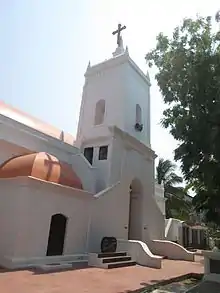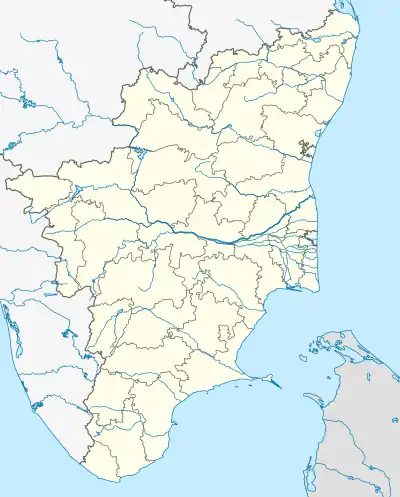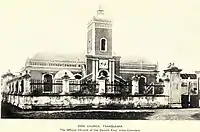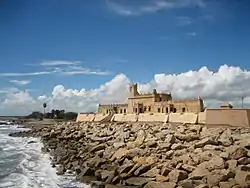| C.S.I Zion Church, Tranquebar, Tamil Nadu, India | |
|---|---|
 Front view of the church | |
 C.S.I Zion Church, Tranquebar, Tamil Nadu, India | |
| 11°01′33″N 79°51′17″E / 11.02583°N 79.85472°E | |
| Location | Tharangambadi, Mayiladuthurai district |
| Country | India |
| Denomination | Church of South India |
| History | |
| Dedication | 1701 |
| Architecture | |
| Functional status | Active |
| Architectural type | Chapel |
| Style | Gothic architecture |
| Administration | |
| Archdiocese | Trichy-Tanjore Diocese of the Church of South India |
Zion Church is one of the oldest churches in Tharangambadi (Tranquebar), a Danish settlement in Nagapattinam district in the South Indian state of Tamil Nadu. It is in the premises of Fort Dansborg, built in the land ceded by Thanjavur king Ragunatha Nayak in an agreement with Danish Admiral Ove Gjedde in 1620 and acted as the base for Danish settlement in the region during the early 17th century. The Church was built in 1701 A.D[1] by Rev. Bartholomaus Ziegenbalg and has records from the 18th and 19th centuries. He is believed to be the first Protestant missionary in India and the Church is believed to be the first Protestant Church in India.
Zion Church is a working church with hourly prayer and daily services and follows Protestant sect of Christianity. In modern times, it is under the dominion of Tiruchirappallli-Thanjavur Diocese of the Church of South India. It is one of the most prominent landmarks of Tranquebar (Tharangambadi).
History

The Dansborg Fort was the most important gateway in the trade route from Europe to Coramandel for the Danish Empire. Protestant missionaries were sent from Denmark by King Fredric IV, who was also the head of Lutheran Church of Denmark. Two of them, namely, Bartholomäus Ziegenbalg and Heinrich Plütschua came to Tranquebar on 9 July 1706 and established the Tranquebar Mission. They learnt Tamil in a few years and were the first to translate and print The New Testament of the Bible in Tamil, in the printing press inside the fort. The Danish mission was the first Protestant mission in India and from its inception, was staffed by German missionaries trained at Pietist schools and seminary founded by Francke at the end of the 17th century.[2][3] The Danes built the Zion Church in 1701, believed to be the first Protestant Church in India and the New Jerusalem Church in 1717.[4] During 1919, a Tranquebar manifesto targeting a single episcopacy for all of Anglican, Lutheran, Presbyterian, Congregational and Wesleyan churches over South India was discussed at this Church, but failed to arrive at a conclusion.[5]
Architecture
Zion Church is enclosed in Fort Dansborg along with a set of buildings, the notable ones being the fort built in 1620, the Masilamaninathar Temple built in the 13th century, New Jerusalem Church built in 1718, the Town Gateway built in 1792, the Danish Governor Bungalow built in 1784 and a series of tomb stones built during the 17th and 18th centuries. The settlement inside the citadel is modeled like a small European town with a land gate and wooden doors leading to the main street, namely, the King's Street.[6][7][8][9]
The church is located two blocks away from the Bay of Bengal and has an exterior made of brick, stained glass windows and tiled brick spires. The architecture indicates common features in Indian structure of the time. The altar houses conventional Methodist images and a prayer hall for the devotees. The plaques of Jesus Christ and some of the apostles are housed in glass chambers in standing posture, on the walls facing the devotees. The church was partially modified in 1782, which is believed to be the structure in modern times. There is a historic bell tower in the church and numerous tombstones too.[4]
Culture

In modern times, the Lutheran Mission administrates the New Jerusalem Church, while the Zion church is under the dominion of the Trichy-Tanjore Diocese of the Church of South India (CSI).[10] The Danish built the Zion Church for the Governors and the New Jerusalem Church for soldiers and the community. Ziegenbalg was the first pastor of the church and he preached in Tamil.[10] There are records from the Church during the period of 1781 to 1814, indicating the burials carried out in the church. They indicate the expenses incurred for building of tombs, funeral services and maintenance of the cemetery.[11]
The Church along with other buildings in the fort were renovated twice in modern times, once by Tranquebar Association with the help of the Danish royal family and the State Archaeology Department in 2001 and secondly by a project named Destination Development of Tranquebar by the Department of Tourism of the Government of Tamil Nadu in 2011.[12][13]
References
- ↑ Datta, Rangan (15 June 2022). "Tranquebar — A piece of Denmark on the coast of the Bay of Bengal". The Telegraph. My Kolkata. Retrieved 26 September 2023.
- ↑ Hoiberg, Dale (2004). Students' Britannica India: Select essays. Popular Prakashan. p. 407. ISBN 9780852297629.
- ↑ Frykenberg, Robert Eric; Low, Alaine M. (2003). Christians and Missionaries in India: Cross-cultural Communication Since 1500. Psychology Press. p. 96. ISBN 9780700716005.
- 1 2 Chakrapani, Saranya (18 May 2015). "Sea Side Story ; Follow the East Coast and the Planes to Unravel Some of the Dravidian Soil's Most Ancient Places of Prayer and History". India Today. Archived from the original on 20 February 2016. Retrieved 15 November 2015.
- ↑ Frykenberg, Robert Eric (1 October 2011). "We Began at Tranquebar. Vol. 1: SPCK, the Danish-Halle Mission, and Anglican Episcopacy in India (1706-1843); vol. 2: The Origin and Development of Anglican-CSI Episcopacy in India (1813-1947.(Book review)". International Bulletin of Missionary Research. Overseas Ministries Study Center. doi:10.1177/239693931103500412. S2CID 147870618. Archived from the original on 20 February 2016. Retrieved 15 November 2015.
- ↑ Manguin, Pierre-Yves; A., Mani; Wade, Geoff (2011). Early Interactions Between South and Southeast Asia: Reflections on Cross-cultural Exchange Volume 2 of Nalanda-Sriwijaya series. Institute of Southeast Asian. p. 226. ISBN 9789814345101.
- ↑ Archaeological Survey of India (1903). Annual Report of the Archaeological Department, Southern Circle, Madras. Madras. p. 28.
tranquebar fort.
{{cite book}}: CS1 maint: location missing publisher (link) - ↑ "Tharangambadi". Nagapattinam District Administration. Retrieved 24 November 2015.
- ↑ "Town of the singing waves". New Delhi: Mint. 20 August 2011. Archived from the original on 10 June 2014. Retrieved 30 November 2013.
- 1 2 Nazareth, Samir (2014). 1400 Bananas, 76 Towns & 1 Million People. Leadstart Publishing PvtLtd. p. 212. ISBN 9789381115800.
- ↑ North, Michael (2010). Artistic and Cultural Exchanges Between Europe and Asia, 1400-1900: Rethinking Markets, Workshops and Collections. Ashgate Publishing. p. 161. ISBN 9780754669371.
- ↑ Chari, Pushpa (10 April 2009). "Capturing the lost magic". The Hindu. Archived from the original on 14 April 2009. Retrieved 7 July 2013.
- ↑ P.V., Srividya (16 July 2011). "Dansborg Fort set to get a facelift". The Hindu. Nagapattinam. Retrieved 24 November 2015.